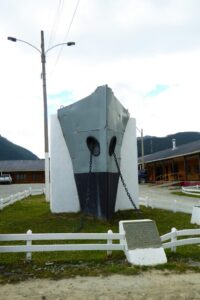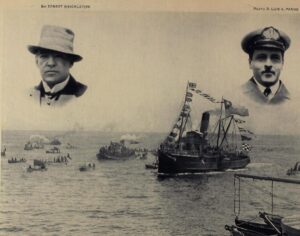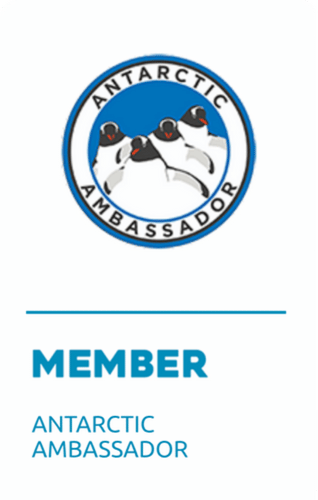Yelcho (1906-1958)
Yelcho was a steam-powered cutter, originally used as a tug before entering Chilean Navy service. It is famous for rescuing the crew of Endurance in 1916, under the command of Luis Pardo Villalón.
 Origins
Origins
Yelcho was built in 1906 by the Scottish firm George Brown and Co. for cargo and towing operations along the central coast of Chile. The original owner, the Sociedad Ganadera e Industrial Yelcho y Palena (Yelcho and Palena Livestock and Industry Company), had a concession to develop land along the Yelcho and Palena rivers, south of Puerto Montt. In 1908 Yelcho was sold to the Chilean Navy and ordered to Punta Arenas where it worked as a tug and for periodic maintenance and supply of the region’s lighthouses.
Rescue of the Imperial Trans-Antarctic Expedition
Shackleton’s Request
In July 1916 the Chilean government authorized Yelcho to assist Ernest Shackleton in rescuing members of his ill-fated Imperial Trans-Antarctic Expedition. After their expedition ship Endurance was crushed by ice in the Weddell Sea, Shackleton and his crew had made their way by foot, sledge and lifeboats to Elephant Island, at the northern tip of the Antarctic Peninsula. From there, Shackleton and five companions had sailed 779 miles (1,253 km) in an open lifeboat to fetch help from whalers on South Georgia. The remaining 22 men were still on Elephant Island.
This was the third attempt to rescue the expedition. Two previous attempts, in May by Southern Sky (loaned by the English Whaling Co) and in June by Instituto de Pesca N°1 (loaned by the Government of Uruguay), had been unsuccesful. Yelcho escorted and towed Emma, a schooner chartered by the British Club of Punta Arenas, to a point 200 miles (320 km) south of Cape Horn, but heavy ice prevented Emma from reaching Elephant Island.
With no suitable ships available, Shackleton begged the Chilean navy to release Yelcho for one last attempt to reach Elephant Island. The Chileans agreed, despite the fact that the ship was unsuited for an Antarctic rescue in the middle of winter. The small, single hull, steel ship was not ice strengthened and had no radio or proper heating system. Shackleton had to promise that he would not take Yelcho into the pack ice.
The Journey South
On August 25, 1916, Yelcho set out from Punta Arenas under the command of piloto Luis Pardo Villalón with Shackleton, Frank Worsley and Tom Crean on board. The ship passed through the channels on the west side of Tierra del Fuego, picked up coal at Picton Island and set off across the Drake Passage on August 28. This time fortune favored them. In Shackleton’s words,
“The little steamer made a quick run down in comparatively favourable weather, and I found as we neared Elephant Island that the ice was open…and the Yelcho had her chance to slip through.”
On August 30, Yelcho approached Elephant Island in a thick fog, continuing on until they could see the sea breaking on a reef. Shackleton wrote, “It was an anxious moment, for we had still to locate the camp and the pack could not be trusted to allow time for a prolonged search.”
 The fog lifted and at 11:40 am Worsley spotted the camp. Yelcho turned in toward the beach and Shackleton called out the customary greeting, “Are you all well?” receiving the reply, “We are all well Boss,” followed by three cheers. Within an hour all of the men were safely aboard and Yelcho steamed north.
The fog lifted and at 11:40 am Worsley spotted the camp. Yelcho turned in toward the beach and Shackleton called out the customary greeting, “Are you all well?” receiving the reply, “We are all well Boss,” followed by three cheers. Within an hour all of the men were safely aboard and Yelcho steamed north.
Arrival in Chile
Yelcho arrived back at Punta Arenas on September 3 and the reception was overwhelming. According to Shackleton, “The whole populace appeared to be in the streets.” When they landed at Valparaiso on September 27 the response was even bigger. This was not only a welcome for the British expedition, but a moment of patriotic pride for the Chilean nation. Shackleton wrote,
“Everything that could swim in the way of a boat was out to meet us, the crews of Chilian [sic] warships were lined up, and at least thirty thousand thronged the streets.”
Aftermath and Legacy
Yelcho was retired from active service in 1945, then used as tender in the Chilean Navy until 1958.
A number of Chilean landmarks and ships have been named ‘Yelcho’ in honor of the daring rescue, including Cape Yelcho, one of Elephant Island’s most prominent fore-lands; Base Yelcho, a scientific base on the Antarctic Peninsula; and the main street of Chile’s southernmost coastal town, Puerto Williams. It is there that the prow of Yelcho has been preserved and is prominently displayed as a tribute to Pardo’s ship and crew.
In Punta Arenas, an urban mural on the Costanera, between José Menéndez and Avenida Colón, depicts the history of Punta Arenas at the beginning of the 20th century. Viewers with a keen eye will spot piloto Pardo and Yelcho in the background of the port scene.
Both the Naval & Maritime Museum and the Salesian Museum have exhibits relating to piloto Pardo and Yelcho. Five miles (8 km) north of the city, a commemorative sign marks the wharf at Rio Seco where Yelcho landed after the rescue.





